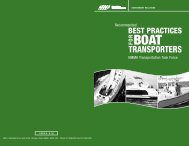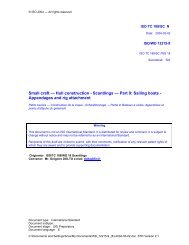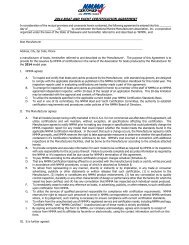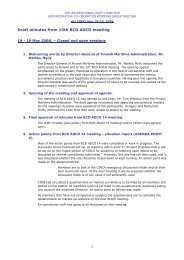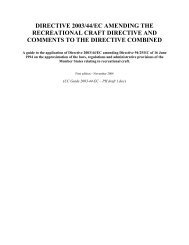global environmental legislation guide - National Marine ...
global environmental legislation guide - National Marine ...
global environmental legislation guide - National Marine ...
You also want an ePaper? Increase the reach of your titles
YUMPU automatically turns print PDFs into web optimized ePapers that Google loves.
The purpose of the IED is to provide for an integrated approach to the prevention andcontrol of emissions in air, water and soil, to waste management, to energy efficiency and tothe prevention of accidents.• Reduce unnecessary administrative burdenIt is intended to reduce the unnecessary administrative burden and to implementcommission conclusions on the thematic strategy of air pollution, soil protection andrecycling of waste. In addition to this, it constraints the use of more flexibleinstruments such as NO x and SO 2 emission trading systems.• Permits and Best Available Techniques (BAT)Activities of the IED must operate according to a permit which should reflect the BestAvailable Techniques (BAT). The permit conditions will be reviewed within four yearsafter the BAT conclusions have been published. Emission limit values specified in theIED should not be exceeded. However it is possible that some values specified in BATreference documents (BREFs) for certain activities may be more onerous than theIED. (Please see attached factsheet BAT/BREFs)• ExemptionsIn certain circumstances, including disproportionate costs compared to<strong>environmental</strong> benefits, the IED allows competent authorities to set emission limitvalues that deviate from BREF levels. The limits of the IED must not be exceeded.Temporary derogations are allowed for testing emerging techniques.• Soil groundwater protection (see also Water Framework Directive)IED requires that the operation does not lead to deterioration in the quality of soil orgroundwater. It also obliges that permit conditions include appropriate measures tomitigate these and that conditions should be included to require monitoring of soiland groundwater to ensure that the mitigation measures are effective. Thefrequency of monitoring will be dependent on the type of prevention measures inplace. Groundwater monitoring should be undertaken at least once every five yearsand soil monitoring at least every ten years, subject to risk assessment. Baselineconditions of a site and restoration back to this status are as per the original IPPCdirective.• WasteAny waste produced must be dealt with in accordance to the waste hierarchy as perthe Waste Framework Directive. Permit applications must include alternativeoptions.Effects/issues of the Industrial Emission Directive (2010/75/EU) for the recreational marineand superyacht industries:• Environmental permit requirements and relation to Best Available Techniques• Emission levels (within <strong>environmental</strong> permit)• Solvent emissions policy and levels (VOC thresholds)• Priority (hazardous) substances• Relation to <strong>National</strong> Emission Ceiling Directive• Relation to pollutant release and transfer register and European pollutant emissionregister8



